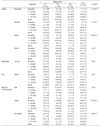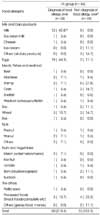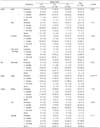1. Ministry of Health & Welfare. Korea Centers for Disease Control and Prevention. Atopy · asthma relief school management guide. 2015. p. 3.
2. Prescott SL, Pawankar R, Allen KJ, Campbell DE, Sinn JK, Fiocchi A, et al. A global survey of changing patterns of food allergy burden in children. World Allergy Organ J. 2013; 6(1):21.
3. Leung TF, Yung E, Wong YS, Lam CW, Wong GW. Parent-reported adverse food reactions in Hong Kong Chinese pre-schoolers: epidemiology, clinical spectrum and risk factors. Pediatr Allergy Immunol. 2009; 20(4):339–346.
4. Prescott S, Allen KJ. Food allergy: riding the second wave of the allergy epidemic. Pediatr Allergy Immunol. 2011; 22(2):155–160.
5. Kay AB. T Cells as orchestrators of the asthmatic response. Ciba Found Symp. 1997; 206:56–67.
6. World Allergy Organization. White book on allergy(section 2.5. Food allergy). 2011. p. 47–53.
7. Rona RJ, Keil T, Summers C, Gislason D, Zuidmeer L, Sodergren E, et al. The prevalence of food allergy: a meta-analysis. J Allergy Clin Immunol. 2007; 120(3):638–646.
8. Jung YH, Ko H, Kim HY, Seo JH, Kwon JW, Kim BJ, et al. Prevalence and risk factors of food allergy in preschool children in Seoul. Korean J Asthma Allergy Clin Immunol. 2011; 31(3):177–183.
9. Allen KJ, Hill DJ, Heine RG. 4. Food allergy in childhood. Med J Aust. 2006; 185(7):394–400.
10. Sicherer SH, Sampson HA. Food allergy. J Allergy Clin Immunol. 2010; 125:2 Suppl 2. 116–125.
11. Oh JW, Kim KE, Pyun BY, Lee HR, Choung JT, Hong SJ. Nationwide study for epidemiological change of atopic dermatitis in school aged children between 1995 and 2000 and kindergarten aged children in 2003 in Korea. Pediatr Allergy Respir Dis. 2003; 13(4):227–237.
12. Han YS. Management of food allergy in the community. Food Sci Ind. 2015; 48(1):24–31.
13. Seo WH, Jang EY, Han YS, Ahn KM, Jung JT. Management of food allergies in young children at a child care center and hospital in Korean. Pediatr Allergy Respir Dis. 2011; 21(1):32–38.
14. Simons FE. Anaphylaxis. J Allergy Clin Immunol. 2010; 125:2 Suppl 2. 161–181.
15. Korea Consumer Agency. Information analysis related to allergies. 2012. p. 1–22.
16. Kang MH, Kim EY, Choi MK. Assessment of nutrient intake and ADHD score in atopic dermatitis preschoolers. J East Asian Soc Diet Life. 2009; 19(4):493–502.
17. Shin JW, Kim WK, Yoon HS. Association of breast-feeding and allergic diseases in preschool aged children. Pediatr Allergy Respir Dis. 2009; 19(4):374–382.
18. Yang SH, Kim EJ, Kim YN, Seong KS, Kim SS, Han CK, et al. Comparison of eating habits and dietary intake patterns between people with and without allergy. Korean J Nutr. 2009; 42(6):523–535.
19. Yum H. Association of brestfeeding and allergic diseases. Pediatr Allergy Respir Dis. 2009; 19(4):325–328.
20. Han YS, Chung SJ, Cho YY, Choi HM, Ahn KM, Lee SI. Analysis of the rate of sensitization to food allergen in children with atopic dermatitis. Korean J Community Nutr. 2004; 9(1):90–97.
21. Kim DS, Ban JS, Park EA, Lee JY, Lee JO, Chang EY, et al. Survey of food allergy in elementary school students in Dongjak-gu using questionnaire. Korean J Asthma Allergy Clin Immunol. 2011; 31(4):254–259.
22. Lee AH, Kim KE, Lee KE, Kim SH, Wang TH, Kim KW, et al. Prevalence of food allergy and perceptions on food allergen labeling in school foodservice among Korean students. Allergy Asthma Respir Dis. 2013; 1(3):227–234.
23. Kim TH. Study on awareness of food allergen labeling [master’s thesis]. Kyonggi University;2013.
24. Lee HS, Hong SC, Kim JH, Kim JW, Lee KH, Lee JC. Prevalence of food allergy and the sensitization rates of food allergens in school-aged children in Jeju. Korean Public Health Res. 2014; 40(3):49–58.
25. Won JH. A study on the awareness and management of food allergy among nutritionist and nutrition teachers in elementary and high schools in Seoul [master’s thesis]. Sookmyung Women’s University;2015.
27. Lee SI. Development of guidelines on infant feeding and weaning for healthy eating habits. Korea Science and Engineering Foundation;2005. Report No. R01-2002-000-00199-0.
28. Kim HI. Research Methods in Sampling. 1st ed. Kyungmoonsa;2014. p. 9.
29. Kim HB, Park YM. Introduction to Statistics. 1st ed. PNCMEDIA;2014. p. 21.
30. Cho CH. SPSS/AMOS utilization, structural equation modeling, statistical analysis. 2nd ed. Chungram;2014. p. 161–162. .
31. Lee MS, Lee KH. Development and application of dietary education to improve the vegetable intake of preschoolers. J Korean Diet Assoc. 2014; 20(1):26–35.
32. Burks AW, Jones SM, Boyce JA, Sicherer SH, Wood RA, Assa’ad A, et al. NIAID-sponsored 2010 guidelines for managing food allergy: applications in the pediatric population. Pediatrics. 2011; 128(5):955–965.
33. Mori F, Serranti D, Barni S, Pucci N, Rossi ME, de Martino M, et al. A kwashiorkor case due to the use of an exclusive rice milk diet to treat atopic dermatitis. Nutr J. 2015; 14(1):83.
34. Kim YG, Yu KH, Ly SY. Perception of elementary school parents in Gyeongbuk area on allergenic food labeling system and children’s food allergy status. Korean J Hum Ecol. 2013; 22(5):491–506.
35. Lee EJ. A study on food allergy occur status and parental perceptions of food allergen labeling system in school food service [master’s thesis]. Pusan National University;2015.
37. Food Allergy Research & Education, Inc. About food allergy [internet]. Food Allergy & Anaphylaxis Network (FAAN) and the Food Allergy Initiative (FAI);2015. cited 2015 Nov 7
Available from: http://www.foodallergy.org/most popular-resources.







 PDF
PDF ePub
ePub Citation
Citation Print
Print









 XML Download
XML Download